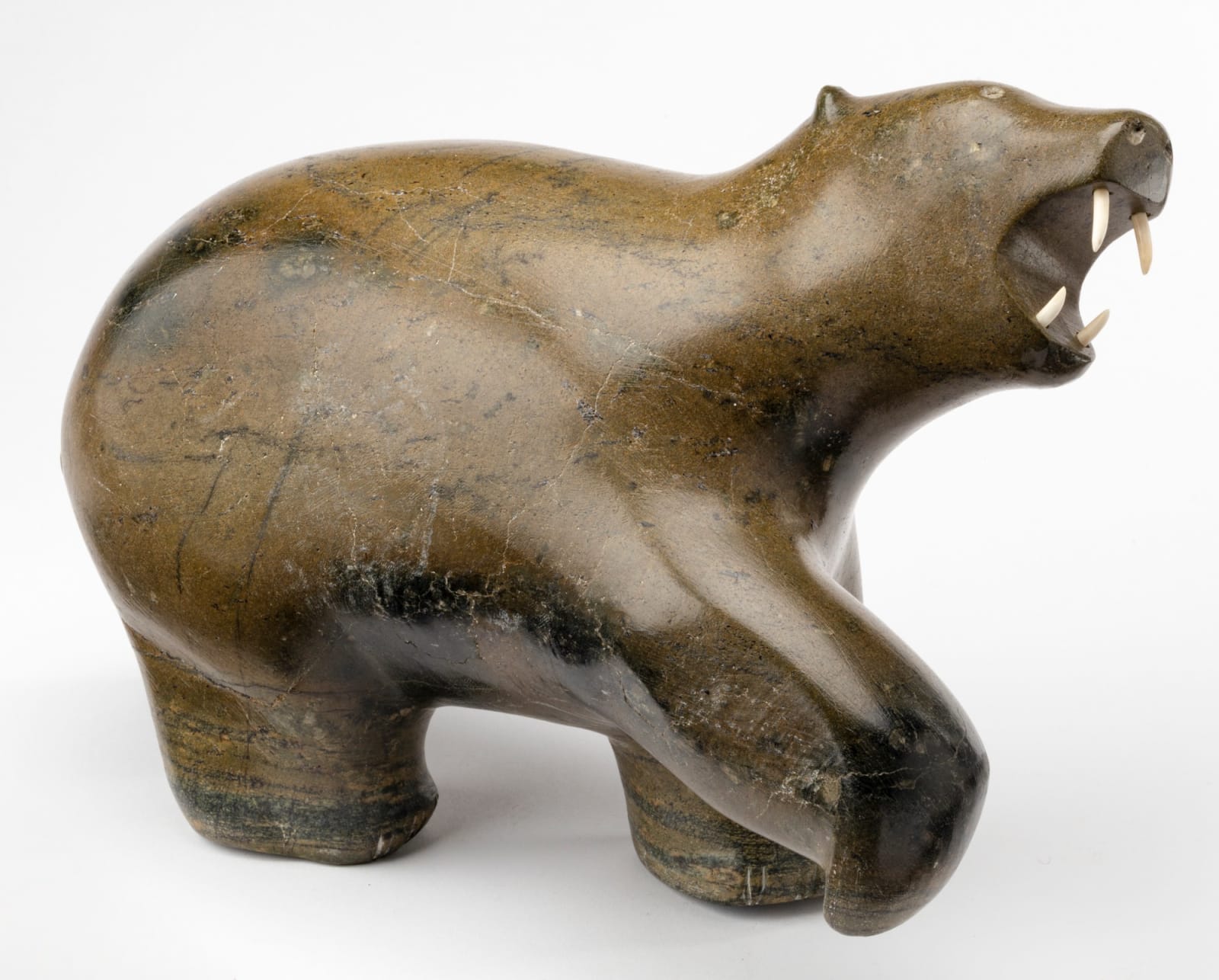PAUTA SAILA, R.C.A. (1916-2009) KINNGAIT (CAPE DORSET)
signed, "ᐸᐅᑕ".
LOT 82
ESTIMATE: $20,000 — $30,000
PRICE REALIZED: $57,600.00
Further images
Pauta Saila’s “dancing bears” are a brilliant invention and are justly famous, but some of Pauta’s most impressive depictions of bears show the animals in more “typical” poses. Important examples include Walking Bear from 1963 (see Walker’s Auctions Nov. 2012, Lot 77); Bear from 1964 in the TD Bank Collection (see Sculpture / Inuit, fig. 158 and elsewhere); Bear from 1964 in the McMichael Canadian Art Collection (see Gustavison, Northern Rock, cat. 8); and Bear from 1967 in the Sarick Collection (see Inuit Modern, p. 116). It is noteworthy that these were all carved in the 1960s, before Pauta had carved many examples of bears standing on one or two feet.
Roaring Bear is contemporaneous with the Sarick example; both are carved in a stone from Markham Bay that had recently been discovered and made available to local sculptors. Pauta carved the stone by hand and burnished it to a lustrous bronze-brown sheen. Looking backwards for a moment at the artist’s long career it is almost astonishing to realize that Pauta had already fully developed his “classic” style by the mid-late 1960s. This outstanding bear’s physiognomy – by which we mean its character and characteristics as defined by its physical appearance – reflects everything we have come to expect in the quintessential “Pauta bear.” The animal’s proportions are compact, sturdy, and powerful but they are also truly elegant. This bear commands our attention, our respect, and even our awe. We’ve never made the connection before, but in a sense this remarkable, Roaring Bear is the Arctic equivalent of an African lion – the King of Beasts.
It is little wonder that Pauta’s bears captured the Inuit art world’s imagination all those decades ago, and little wonder that his bears continue to impress us today. Roaring Bear doesn’t need to dance to catch our attention. It’s hard to look away.
References: For similarly posed works by the artist see George Swinton, Sculpture of the Inuit, (Toronto: McClelland & Stewart, 1972/92), fig. 158 (TD BANK), also illustrated in Bernadette Driscoll, Uumajut: Animal Imagery in Inuit Art, (Winnipeg: Winnipeg Art Gallery, 1985), cat. 1, and in Christine Lalonde and Natalie Ribkoff, ItuKiagâtta! Inuit Sculpture from the Collection of the TD Bank Financial Group, (Ottawa: National Gallery of Canada, 2005), pl. 11, cat. 38. See another similar example in Gerald McMaster, ed., Inuit Modern: The Samuel and Esther Sarick Collection, (Toronto: Art Gallery of Ontario, 2010), p. 116; for another fine example see Susan Gustavison, Northern Rock: Contemporary Inuit Stone Sculpture, (Kleinburg: McMichael Canadian Art Collection, 1999), cat. 8. For important Pauta “dancing bears” see Ingo Hessel, Inuit Art: An Introduction, (Vancouver: Douglas & McIntyre / New York: Harry Abrams / London: British Museum Press, 1998), front cover and fig. 102; and First Arts, July 2020, Lot 46.
Provenance
Private Collection, Santa Fe, NM.Join our mailing list
* denotes required fields
We will process the personal data you have supplied in accordance with our privacy policy (available on request). You can unsubscribe or change your preferences at any time by clicking the link in our emails.








